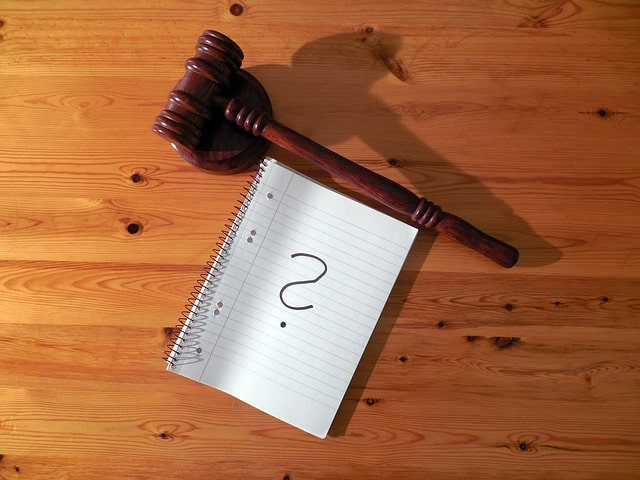Dictamen: what it is, main characteristics, types and keys to writing
Contents
What is an dictamen?
It consists of a type of expression through which a judgment or statement is issued in relation to a given situation. That is to say, the opinion is a type of judgment of a judicial nature that is enunciated in such a setting, either directly by a judge or a court. However, it is also used to refer to an assessment made about a particular person or object.

It is part of the types of oral expression due to its emission through speech, although it is also possible to record it through documents that are given in this professional field. With the enunciation of an opinion, a litigation or cause is finalized, since it is oriented to recognize the right of any of the parties involved in the process, determining that the other party must accept the resolution.
Main characteristics of the dictamen
Let’s see some key features about this oral expression and that facilitate the distinction from others that are part of this same type of manifestations. Its most important characteristics are:
Function of the dictamen
The purpose of the opinion, or the use given to this expression, has to do with the recognition, in a general way, of an assessment or opinion issued with respect to some circumstance, object or person. For example, an opinion takes place when a person refers to the personality of another, where the opinion is constituted from the experience, impression and perception that has been formulated about it.
Spheres in which it is developed
The opinion is an expression that is issued mainly in the professional field of law and politics, so it is a type of statement that is frequently found in the legislative context and in the judicial context. Although these are mainly the fields in which it is developed, it is also possible to find it in various environments.
Other instances
The opinion is also applied within other spaces or disciplines of a professional nature in which specialists use it through the issuance of assessments in fields such as psychiatry, psychology, among others. This is because it also refers to precise information that is provided exclusively by a professional in a given field.
It is important to mention that, ultimately, the conditions and particularities of the opinion depend precisely on the type to which they belong, as well as the field in which they are applied.
Types of dictamen
In the case of opinions that take place in the contexts of the legislative and judicial branch, it is possible to identify four types of opinions that are important within them for different processes. Subsequently we will look at the types of opinions in the field of auditing. In order, the first types of opinions, are:
Condemnatory dictamen
In this case, the judge responds favorably to the claim of the person who is executing the lawsuit.
Acquittal dictamen
In the second case, the judge chooses to give the reason to the person who is being accused within the lawsuit process.
Final Judgment
In this type of ruling, no appeal is accepted once the ruling has been determined. These appeals may also be appeals or claims.
Appealable dictamen
Finally, the fourth type of opinion is that in this case it is viable the interposition of some type of recourse that is provided after the opinion has been expressed or heard.
Other types of dictamen in this field are:
Condemnatory dictamen
In this type of opinion, the judge, in the face of those claims presented by the plaintiff, accepts them, which is also known as punishing the defendant.
Acquittal judgment
As its name indicates, this opinion is characterized by acquitting or pardoning the person who is being accused in the lawsuit process.
Expert dictamen
This opinion, in law, is generated by an expert who makes it based on his area of knowledge with the intention of clarifying and verifying the facts that are of interest in the trial and of which it is necessary to know in any field, whether scientific or technical, especially. It is a type of opinion that can be used by any of the two parties involved and even by the judge of the case. It is necessary that it is precise and objective in order not to generate confusion.

Types of audit opinion
It is also possible to identify other types of opinions in the financial field, in particular when reference is made to an opinion that an auditor issues when performing an external audit. In this case, there may be other types such as the following:
Qualified dictamen
This is generated when the auditor finds that, although the balance sheets have shown a reasonable result, there are some elements that could generate a possible loss or qualification within the actions that the company has taken.
Unqualified dictamen
This opinion takes place when the results provided by the Balance Sheet, the Statements of Changes and the Statements of Income are seen as reasonable by the auditor. This means that they comply with the established accounting principles.
Opinion with disclaimer of dictamen
This type of opinion is developed when the auditor is limited by the company to the investigation of elements that could contribute to the solution of possible irregularities that have been identified with respect to the result of the Balance Sheet. In this case, not having access to the necessary details of the transactions, the auditor must make an impartial decision.
Structure of the dictamen
As we have seen, there are many types of opinion that can be generated in different areas, as well as a series of characteristics that distinguish them, including their structure. This is why it is not possible to establish or identify a type of structure that applies to all of them, even in the same legal field. However, most of them include a series of distinctive elements that we will see below:
Introduction
In this first part of the opinion it is necessary to highlight the objective on which the opinion is going to be developed. In addition to this, it is necessary to mention the person requesting the opinion, and then write the subject in a general overview. Regarding the length, this may vary depending on the case, including a few paragraphs that serve to contextualize the addressee.
In general, in this part some choose to place the cover page with contact information, in some cases, and if it is an opinion in development of an academic work, other data corresponding to the institution are determined. It is also necessary to place a heading in which the information of the report is presented in a synthesized way.
Development of the facts
In the second part of the text it is necessary to locate the objective facts for which the request of the opinion is generated. In an organized manner, each of the facts is written, which must follow a chronological order and be divided, most of the time, by numbers.
Each of the sections must refer to a specific fact. It is important that the fact is written in a brief and concise manner for the addressee, highlighting the most important data that will be key in the resolution of the case. It is not necessary to include the identification or mention of personal data, but substitute terms are used.
Approaches and regulations
This section begins to clearly establish the specific legal issues, which are directed to the resolution in the opinion. It is important that each of the approaches that are developed here are explained as clearly as possible, as well as to occupy as little space as possible in writing.
The following section should be a compilation of the regulations, doctrine and jurisprudence that will be applied in the resolution based on the development of the facts and the subsequent approaches. These will be organized as follows:
Regulations
The legal norms that can be applied are identified, from the highest to the lowest, such as the constitution, laws, decrees and others. Each of the elements indicated must be cited correctly in the section and mentioned in lower case letters followed by the type of norm, the number or year, the date and the title. It is necessary to identify why it applies to the case.
Jurisprudence
It must be explained in an organized manner, considering the pyramidal structure, in which the most important information of the case is placed in hierarchical order, followed by complementary information and data, but fundamentally necessary for its presentation. Each of the data must be cited correctly, following the Judgments and other aspects, including the applicability with respect to the case.
Doctrine
If added, a specific section should be included in which the legal doctrine that, although it is not a source of law, is of importance and interest for the resolution of any of the issues that have been raised, should be presented. It is necessary to mention both the title and the author’s name in a separate paragraph. The author’s opinion on the approach or problem must be mentioned in small letters and the data must be repeated in the Bibliography section.
Legal grounds
This section should present the facts and also the legal issues within the legal grounds, which will allow the resolution of the issues that have been previously identified. A numbered section is used for each of the issues and should contain all the arguments both for and against.
More space may be required if you wish to present issues that, although outside the subject matter of the consultation, are important because they can be connected to the issues identified in the opinion. This section corresponds to additional information that may or may not be added.
Conclusions
Finally, this section presents a short summary of the suggested solution for each of the issues or questions developed and of a legal nature, which constitutes the final opinion. Since this is a summary of what happened, it is necessary to ensure that the resolution is not too long, as it has been presented in the section on the development of the facts and issues.
It is recommended that the conclusions be developed following the same order in which the legal issues to which a resolution was determined were presented. In turn, these should be divided into separate sections following the writing of the figures or order. Here you can add data such as the place, the date in letters and the subsequent signature of the person issuing the opinion.

Keys to writing an dictamen
Below we will see a series of fundamental aspects for the writing and, in general, the development of this type of texts. These are elements that should be considered at the time of writing and that will be important for a correct reading. These keys are:
Conclusion information
It is recommended that in this section, although a summary of the facts and issues is made, no new information should be incorporated or added. That is, since different aspects and data have been raised in the development, no new information, data or any other aspect that is new should be included in the conclusions.
Connection of technical analysis
In the development of the text it is essential that the conclusions and final sections are correctly connected with the criteria, issues and technical analyses that have been presented previously within the report, i.e. within the opinion. In other words, the final considerations must be properly based on the information presented in the content.
Clear language
It is important to consider that the opinion may be read by different people, which is why special care should be taken with the type of language you choose to use. Although much of the information will be technical, as well as the exposition of the regulatory and related sections, it is important to ensure that it is provided in a clear and concise manner so that any person, even without specialized knowledge, can understand what each of the exposed sections refers to.
Objectivity of the content
Another important aspect when drafting an expert opinion is the objective nature that should be included in the report. Particularly in the expert opinion type, the writer should refrain from including in his or her writing opinions or assessments in relation to the circumstances or facts that have been raised throughout the document. Instead, judgments are made based on objective reasoning and supported by expert knowledge.
Knowledge of information
In addition to the specialized knowledge that one must have, it is very important to have a clear and complete knowledge of the nature of the engagement, as well as the background and development of the facts, a process that will allow a better study and analysis of the corresponding procedures.
Development of all approaches
It is essential that none of the issues, statements or assertions presented in the document are left without justification or follow-up. In this case, the presentation of the information must be duly answered, so that all estimates and data are explained and justified.
The opinion is one of the types of oral literature, but with the passage of time, it has doubled its way with the recording of information, so it would also be possible to place it in the field of written literature. If you want to know more about other types of literature and characteristics, remember that in our section you will find much more information to continue learning about them.
